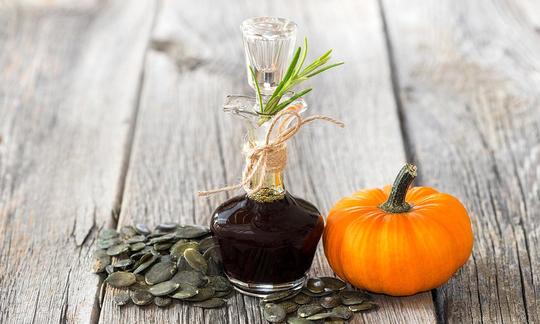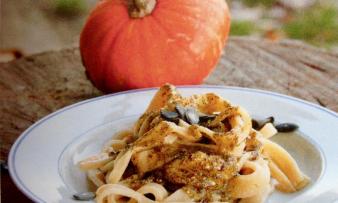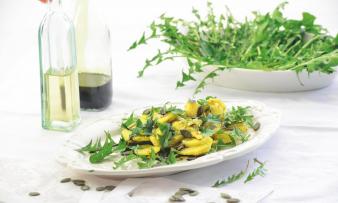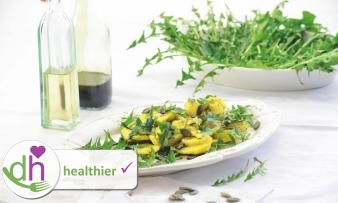Table of contents
Styrian pumpkin seed oil is traditionally made from roasted seeds of the Styrian oil pumpkin ( Cucurbita pepo var. styriaca). There is also pumpkin seed oil made fromunroasted seeds. The "green gold" is also called pumpkin oil or kernel oil.
Use in the kitchen
Good pumpkin seed oil has a rather thick consistency and smells pleasantly nutty, sweet, with a typically aromatic taste. The color varies from dark green to reddish brown, depending on the degree of roasting and the thickness of the oil layer. 7
Pumpkin seed oil is an excellent dressing for raw vegetables and all kinds of salads. The oil also enhances many other dishes such as soups, casseroles, risottos and pasta. With its sweet taste, it is even suitable for special desserts such as ice cream, parfaits, puddings and cakes. Pumpkin seed oil goes perfectly in creamy spreads on bread and rolls or in dips with fresh vegetable sticks.
Althoughpumpkin seeds are usually roasted before the oil is made, pumpkin seed oil (from roasted and unroasted pumpkin seeds) is one of the heat-sensitive oils. When heated above 120 °C, pumpkin seed oil loses its greenish color, its aromatic taste and some of its healthy ingredients. Pumpkin seed oil is not suitable for frying or deep-frying, but can be used as a baking ingredient for cakes and tarts. 1
Food containing pumpkin seed oil should not be placed in the sun, as UV light makes the oil bitter.
Vegan recipe for vegetable carpaccio with pumpkin seed oil
Ingredients: 1 beetroot, 1⁄2 radish, 1 red onion, 2 carrots, 4 tbsp vegan sour cream, 1 tbsp apple cider vinegar, 2 tbsp pumpkin seed oil, salt, herbs.
Preparation: Wash the root vegetables well and slice them very finely using a vegetable slicer. Arrange the sliced vegetables nicely on a plate. For the dressing, stir all the ingredients until smooth and add a dollop to the vegetables. Wash the herbs, shake off the water and spread over the carpaccio.
Vegan recipes with pumpkin seed oil can be found under the note: " Recipes that have the most of this ingredient ".
| Not only vegans or vegetarians should read this: Vegans often eat unhealthily. Avoidable nutritional errors. |
Purchasing - Storage
The most well-known and high-quality pumpkin seed oil comes from the Austrian region of Styria. Styrian pumpkin seed oil is often referred to as the original, as the Styrian oil pumpkin ( Cucurbita pepo var. styriaca) comes from this region. There is also pumpkin seed oil from other regions and pumpkin varieties.
Styrian pumpkin seed oil is geographically protected and bears the name with the abbreviation PGI (protected geographical indication). Traditional Styrian pumpkin seed oil consists of roasted seeds of the oil pumpkin Cucurbita pepo var. styriaca. 1.4
Is Styrian pumpkin seed oil a cold-pressed pumpkin seed oil? The oil is not actively heated during the pressing process. It is not a hot pressing. However, since the raw material is heated or roasted beforehand, it is not a cold-pressed oil in the legal sense. 4 You can find out more by clicking on Cold-pressed oils (laws, raw food).
Pumpkin seed oil made from unroasted pumpkin seeds is available online, usually also from organic production. It should be noted that the product cannot be called "Styrian pumpkin seed oil", even if it comes from this region. The color of the unroasted oil is greenish-yellow, which is significantly lighter than the roasted, greenish-brown pumpkin seed oil. 4
You can occasionally find genuine Styrian pumpkin seed oil in supermarket chains such as Coop, Migros, Denner, Volg, Spar, Aldi, Lidl, Rewe, Edeka, Billa or Hofer and in organic supermarkets such as Denn's Biomarkt or Alnatura. If possible, buy organic pumpkin seed oil, which you can find in health food stores, organic shops, drugstores - or you can order online from a trustworthy supplier or directly from the producer. Pumpkin seed oil can be contaminated with pesticides. The consumer, an Austrian test magazine, found significantly fewer pesticides in pumpkin seed oils in 2019 than in 2012, but certain oils contained the legal maximum level. 2
Mixtures with other cooking oils must be labelled as salad oil, cooking oil or table oil with the percentage of pumpkin seed oil. However, this often leads to consumer confusion. Products sold as "real pumpkin seed oil" often contain diluted pumpkin seed oil. Externally, these blended oils are almost indistinguishable from real pumpkin seed oil. 1 The consistency of the mixed version is a little thinner, the colour is not as intense and a "greasy" taste indicates an inferior product.
Pumpkin seed oil is available all year round. The availability of pumpkin seed oil varies depending on the size of the store, catchment area, etc. You can find our recorded food prices for the DA-CH countries above under the ingredient image - and by clicking you can see their development at various suppliers.
Cold-pressed oils (laws, raw food)
In Switzerland, oil is considered cold-pressed if the oilseed was not heated, the pressing temperature did not exceed 50 °C and no problematic post-treatment has taken place. According to the Federal Department of Home Affairs ( EDI), an edible oil is considered cold-pressed (or may be described with synonyms such as (extra) virgin, unrefined, cold-pressed or natural) if it is obtained by pressing or centrifuging from previously unheated raw materials, the temperature during pressing did not exceed 50 °C and there was no refining, i.e. no neutralisation, no treatment with adsorbents, bleaching earth and no steaming.
An oil may be described as “gently steamed” if the refining process was limited to steaming and did not exceed 130 °C. 18
In the EU and the USA, there does not appear to be a generally applicable temperature limit set by law for cold-pressed oils. For example, the guidelines for edible fats and oils of the Federal Ministry of Food and Agriculture (D) are similar to the EDI regulation, but they do not specify a permissible maximum temperature for general cold pressing - since they only apply to products whose labelling and composition are not conclusively set by law (i.e. not for olive oil, cocoa butter, milk fats, spreadable fats). 19
On the other hand, both the EU directives and the amendment to the EDI regulation on foods of plant origin, mushrooms and table salt (and its amendment) provide for a special rule for the labelling of olive oils. 20,21
These are selective marketing rules in which the term raw food is not defined. "Raw food" and "raw" are therefore not state-protected terms (as is the case with the term "organic"), which leaves a lot of room for interpretation. Although it is agreed that with purely mechanical cold pressing, the pressing temperatures generally do not exceed 40 °C, one should not naively assume that cooking oils are raw food quality. There is a suspicion that the measuring method used does not indicate the temperature in the press cylinder (where the heat is highest), but only the outlet temperature in the oil hose. With water-cooled olive oil presses (so-called "water-cooled 37°" oil presses), one probably cannot even say with certainty what the actual heat is inside the press cylinder, because the entire press cylinder is surrounded by cooling sleeves.
In addition, the pressing pressure and speed as well as the moisture content of the oilseed affect the pressing temperature. If, for example, the moisture content is too low, the temperature rises during pressing and it is difficult to stay even below the maximum limit of 50 °C. 22
Storage tips
How long can you keep pumpkin seed oil? If stored in a cool (below 20° C) and dark place, the oil will last for a good 12 months in a sealed bottle. 16
Opened bottles are best kept in the refrigerator. These should be used within 2-3 months, as the oil begins to oxidize due to oxygen and loses its vitamins and aroma. Pumpkin seed oil that smells rancid should definitely be thrown away. Look for bottles made of dark glass. This provides better protection against light.
Ingredients - Nutritional values - Calories
Pumpkin seed oil contains a lot of calories (884 kcal/100g), which come exclusively from fats. Carbohydrates and proteins are not found. 18 g of 100 g are saturated fats. 17
Pumpkin seed oil contains 112 µg/100g of vitamin K. This is high compared to other oils. For example, rapeseed oil has 70 µg, olive oil 60 µg and walnut oil only 15 µg per 100 g. 26 Certain pumpkin seed oils contain selenium in addition to alpha and beta tocopherol ( vitamin E). 5
The complete ingredients of pumpkin seed oil, the coverage of the daily requirement and comparison values with other ingredients can be found in our nutrient tables. In the article Nutrients explained you will get a detailed insight into the topic.
Effects on health
What is pumpkin seed oil good for? In natural medicine, pumpkin seed oil is used to treat bladder and prostate problems. A 12-week study showed that daily consumption of pumpkin seed oil (here in capsule form) led to a reduction in the symptoms of an overactive bladder. The substances in pumpkin seed oil that are responsible for this are the subject of research. 10
It is not yet clear whether pumpkin seed oil helps with benign prostatic hyperplasia (BPH). Benign enlargement of the prostate is treated with blockers that inhibit the conversion of testosterone into dihydrotestosterone (DHT). Pumpkin oil contains substances that inhibit DHT. 3 studies by the Taiwanese National Cheng Kung University from 2006 demonstrated the healing power of pumpkin seed oil for an enlarged prostate, but only in an animal experiment. 11
A Korean study from 2014 led to pumpkin seed oil being considered a possible remedy for genetically caused hair loss. 76 male participants were given 400 mg of pumpkin seed oil daily for six months. However, they did not use pure pumpkin seed oil, but rather a mixture with other dihydrotestosterone (DHT) blocking substances. 14 The external use of pumpkin seed oil against hair loss has so far only been studied in mice. The results were promising. Further studies are needed to understand the effect in detail. 9 Further research is needed to determine the potential of pumpkin seed oil or extracts from it in the treatment of prostate problems and hair loss.
Several ingredients contained in pumpkin seed oil have antioxidant and antimicrobial effects (see secondary plant substances). 8
Pumpkin seed oil is also said to have a cholesterol-lowering effect. A Jamaican study from 2011 examined pumpkin seed oil for its potential benefits. In postmenopausal subjects, it had a blood pressure-lowering effect. HDL cholesterol levels also increased. However, the treatment was only 2 g of pumpkin seed oil daily for 12 days. 13
Secondary plant substances
Many of the health effects of pumpkin seed oil can be attributed to the secondary plant substances it contains. Our article on secondary plant substances provides an overview of the classification of substance groups, their occurrence in foods and possible effects on humans.
Pumpkin seed oil contains the carotenoids lutein and zeaxanthin. Other secondary plant ingredients are phytosterols,beta-sitosterol, delta-7-sterols, squalene, tocopherols, polyphenols and phytoestrogens. 5,6,8
The polyphenols, tocopherol (vitamin E) and carotenoids contained in it have an antioxidant effect. 8
However, it should be noted that the composition of the secondary plant substances in pumpkin seed oil can vary depending on the variety, time of harvest and growing conditions. Therefore, quantities are only of limited use and should only be understood roughly.
Dangers - Intolerances - Side effects
The most important criteria for assessing an oil as "healthy" or "unhealthy" are the content of unsaturated fatty acids and the ratio between omega-6 and omega-3 fatty acids. Unfortunately, pumpkin seeds and pumpkin seed oil have a very poor ratio. Pumpkin seed oil has little alpha-linolenic acid (0.48 g/100g) and a high proportion of linoleic acid (49 g/100g). The ratio between the inflammation-promoting omega-6 fatty acids (LA) and the anti-inflammatory omega-3 fatty acids (ALA) is alarmingly high (102 LA: 1 ALA). Inpumpkin seeds (dried), the ratio is as high as 172:1. 5.17
Linoleic acid forms arachidonic acid (ARA), which is converted into hormone-like eicosanoids that have an inflammatory and vasoconstricting effect, promote arteriosclerosis and the sensation of pain. Alpha-linoleic acid forms eicosapentaenoic acid (EPA) and docosahexanoic acid (DHA), which form eicosanoids that have anti-inflammatory, antithrombotic and bronchodilating and vasodilating effects. Since both conversion processes use the same enzymes, they compete with each other. 24
According to Dr. Michael Greger, the ideal omega-6 to omega-3 ratio is 1:1 in order to maintain a balance between the two conversion processes in the body. The guidelines of the Federal Nutrition Commission (EEK) are less strict and recommend reducing the ratio to at least 5:1. 23 Therefore, instead of pumpkin seed oil, you should use linseed oil (1:4), walnut oil (5:1) and cold-pressed rapeseed oil (2:1) for cold dishes and refined rapeseed oil for frying and cooking, which have a good omega-6 to omega-3 ratio. 5
It is even healthier not to consume oil, but rather seeds and nuts. All oils are concentrated foods that have gone through various processing steps. In general, whole, unprocessed foods such as nuts or seeds are preferable.
Folk medicine - naturopathy
In naturopathy, pumpkin seed oil is used for the following complaints: arteriosclerosis, difficulties in emptying the alkaline system, prostate problems, bladder infections, high blood pressure, disc problems, muscle cramps, kidney diseases and against intestinal worms. 15,16
Ecological footprint - animal welfare
The CO 2 footprint is primarily used to assess the climate friendliness of a food. This depends on various aspects such as cultivation method (conventional/organic), seasonality, country of origin, processing, transport and, if applicable, packaging. Despite extensive research, we were unable to find any data on the CO 2 footprint for pumpkin seed oil.Pumpkin seeds can have a footprint of 0.89 kg CO 2 eq/kg from the field. This value increases to 4.19 kg CO 2 eq/kg through drying and transport. Pumpkin seed oil probably has a similar value. By comparison, olives have 0.31 kg CO 2 eq/kg (from the field) and olive oil 3.06 kg CO 2 eq/kg. 12
We were also unable to find any data on the water footprint of pumpkin seed oil. Pumpkins have an average water consumption of 336 l/kg. 25 The water footprint of pumpkin seed oil is likely to be many times higher.
For detailed explanations of various sustainability indicators (such as ecological footprint, CO2 footprint, water footprint), see our article: What does the ecological footprint mean?
Worldwide occurrence - cultivation
Pumpkin seed oil is made from the seeds of the domesticated garden pumpkin ( Cucurbita pepo ssp. pepo). This originally comes from southern Mexico (gene center). Today it is cultivated worldwide in warm and temperate climates. Pumpkin seed oil is produced in southeastern Europe, Africa and China, using different varieties of Cucurbita pepo. 3
Pumpkin seed oils often have a transparent color. Styrian pumpkin seed oil is known for its dark, green-brown color. The seeds of the Styrian pumpkin (C ucurbita pepo ssp. pepo var. styriaca) are used for this oil. It has been cultivated in Styria (Austria) since the first half of the 19th century. It is characterized by its very thin shell (shellless pumpkin seeds). This makes oil extraction easier and gives the oil its characteristic color. 3
Cultivation - Harvest
Information on pumpkin cultivation and the pumpkin season can be found under the ingredient Pumpkin, raw.
Industrial production
Pumpkin seed oil is extracted from the seeds of garden pumpkins by cold pressing or pressing using heat, whereby the seeds can be pressed peeled or unpeeled. 16 It is difficult to verify which temperatures are reached here.
To make Styrian pumpkin seed oil, the seeds of the Styrian oil pumpkin are dried, chopped and mixed with water and salt. This mass is roasted for 30-60 minutes at 100 °C until the water has evaporated. The roasting causes a Maillard reaction, which is responsible for the typical nutty aroma of pumpkin seed oil. The so-called oil cake is then pressed mechanically or hydraulically to obtain the pumpkin seed oil. The pressing process takes place under isothermal conditions between 300 and 600 bar. The dark green oil is then filled into dark glass bottles to protect it from sunlight. The oil is not refined. The oil is neither degummed, (partially) deacidified, bleached, deodorized nor fractionated. 3,4,16
Further information
Garden pumpkins ( Cucurbita pepo ssp. pepo) belong to the pumpkin genus ( Cucurbita) within the gourd family (Cucurbitaceae). The Styrian oil pumpkin ( Cucurbita pepo var. styriaca) is descended from the garden pumpkin ( Cucurbita pepo).
For more information about pumpkin, see the ingredients: Hokkaido pumpkin, butternut squash, summer squash and pumpkin, raw.
Alternative names
Alternative names for pumpkin seed oil are pumpkin oil, kernel oil, farmers' kernel oil or Styrian pumpkin seed oil.
The English name is pumpkin seed oil.
Other uses
Is pumpkin seed oil good for the skin? Pumpkin seed oil is often used as a carrier oil in cosmetics because it contains many active ingredients such as vitamin E and carotenoids, which have good skin-care properties. Pumpkin seed oil is said to help with dry skin, the formation of wrinkles and fine lines, skin aging, stretch marks and flaky and cracked skin. 16
Bibliography - 25 Sources
| 1. | Steirisches Kürbiskernöl g.g.A. Herkunft, Produktion, Tipps zur Verwendung. |
| 2. | Kosument. Kürbiskernöl - Echt steierisch? 2019. |
| 3. | Fruhwirth GO, Hermetter A. Seeds and oil of the Styrian oil pumpkin: Components and biological activities. European Journal of Lipid Science and Technology. 2007;109(11):1128-1140. |
| 4. | Österreichisches Lebensmittelbuch. Kürbiskernöl. |
| 5. | USDA United States Department of Agriculture. |
| 6. | Procida G, Stancher B et al. Chemical composition and functional characterisation of commercial pumpkin seed oil. J Sci Food Agric. 2013;93(5):1035-1041. |
| 7. | Kreft S, Kreft M. Physicochemical and Physiological Basis of Dichromatic Colour. Naturwissenschaften. 2007;94:935-939. |
| 8. | Šamec D, Loizzo MR et al. The potential of pumpkin seed oil as a functional food-A comprehensive review of chemical composition, health benefits, and safety. Compr Rev Food Sci Food Saf. 2022 Sep;21(5):4422-4446. |
| 9. | Hajhashemi V, Rajabi P, Mardani M. Beneficial effects of pumpkin seed oil as a topical hair growth promoting agent in a mice model. Avicenna J Phytomed. 2019;9(6):499-504. |
| 10. | Nishimura M, Ohkawara T, Sato H, Takeda H, Nishihira J. Pumpkin Seed Oil Extracted From Cucurbita maxima Improves Urinary Disorder in Human Overactive Bladder. J Tradit Complement Med. 2014 Jan;4(1):72-74. |
| 11. | Tsai YS, Tong YC et al. Pumpkin seed oil and phytosterol-F can block Testosterone/Prazosin-induced prostate growth in rats. Urol Int. 2006;77(3):269-74. |
| 12. | Carbon Cloud. Pumpkin seeds, with shell (Greece), Pumpkin seeds, with shell (USA), Olives (Spain), Olive Oil, 0.75 l glass bottle (UK). |
| 13. | Gossel W, Hyde C et al. Improvement in HDL cholesterol in postmenopausal women supplemented with pumpkin seed oil: pilot study. Climacteric. 2011;14(5):558-564. |
| 14. | Young HC, Lee SY et al. Effect of Pumpkin Seed Oil on Hair growth in Men with Androgenetic Alopecia: A Randomized, Double-Blind, Placebo-Controlled Trial. Evid Based Complement Alternat Med. 2014;1:549721. |
| 15. | Pahlow M. Das grosse Buch der Heilpflanzen. Nikol Verlag: Hamburg. 2013. |
| 16. | Krist S. Kürbiskernöl. In: Krist S (Ed.) Lexikon der pflanzlichen Fette und Öle. Springer; 2013: 397-405. |
| 17. | DEBInet Deutsches Ernährungsberatung- & -informationsnetzwerk. Kürbiskernöl. |
| 18. | Eidgenösisches Departement des Innern. Verordnung des EDI über Speiseöl, Speisefett und daraus hergestellte Erzeugnisse vom 23. November 2005 (Stand am 9. April 2015). |
| 19. | Bundesministerium für Ernährung und Landwirtschaft. Leitsätze für Speisefette und Speiseöle. Neufassung vom 02.07.2020 (BAnz AT 18.08.2020 B3, GMBl 2020 S. 530). |
| 20. | Amtsblatt der Europäischen Union. Durchführungsverordnung (EU) Nr. 29/2012 der Kommission vom 13. Januar 2012 mit Vermarktungsvorschriften für Olivenöl. Artikel 5 a) und b). |
| 21. | Eidgenössisches Departement des Innern. Verordnung des EDI über Lebensmittel pflanzlicher Herkunft, Pilze und Speisesalz (VLpH). Änderung vom 8. Dezember 2023. Inkrafttreten: 1. Februar 2024. |
| 22. | Schaufler D. Oilseed Fact Sheet: Oilseed Presses. Dept. of Agricultural and Biological Engineering, Penn State College of Agricultural Sciences. |
| 23. | Eidgenössische Ernährungskommission. Fette in der Ernährung (2006). |
| 24. | Biesalski HK, Bischoff SC, Pirlich M et al. Ernährungsmedizin. 5. Auflage. Thieme: Stuttgart, New York. 2018. |
| 25. | Mekonnen MM, Hoekstra AY. The green, blue and grey water foodprint of crops and derived crop products. Hydrology and Earth System Sciences. 2011;15(5):1577-1600. |











Comments